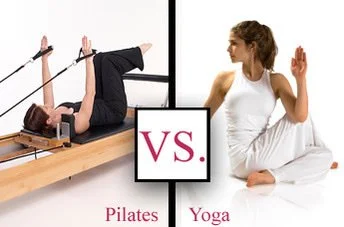Yoga vs. Pilates - WHAT’s THE DIFFERENCE?
"Should I take Yoga or Pilates?" As complementary movement practices, Yoga and Pilates invite understandable confusion. Both build strength and flexibility, focus on breathwork, and promote mind-body awareness. At first glance, Yoga and Pilates may seem strikingly similar, but they are in fact quite different practices. Personally, I love them both for different reasons.
Dynamic vs Static
A traditional vinyasa yoga practice incorporates dynamic movement: continuously transitioning from one pose to another, often synchronized to the breath. One inhale could sweep your arms overhead; an exhale might fold you forward (check out Yoga with Adriene as a great example). This dance-like, lyrical style marks a sharp contrast to the precisely controlled isolations of Pilates (there are, of course, other forms of Yoga that are more static).
In a Pilates mat routine, the foundation of movement lies in stabilization rather than flow. You'll draw in while holding a spine curl, engage through your center as you open one leg to the side, then pulse just your sternum up and down. Most movements are much more contained, small, and concise rather than expansive and continual (here are some examples). This builds endurance rather than mobility.
Internal vs External Focus
The mental approach also differs. In yoga, an inward orientation leads you to witness sensations, events, and stimuli with impartiality rather than reaction. Meditation plays a key role.
Conversely, Pilates keeps attention fixed outward on moving parts of the body with control, accuracy and efficiency. The mind actively instructs specific muscles to contract and release. You think through sequencing rather than emptying thoughts. The external focus supports rehabilitation goals and motor learning. In this blog, the author talks about how she prefers pilates instead of yoga because it helps with her joint pain and overall bodily movement.
Spiritual vs physical
Historically, the purpose behind yoga reached beyond physical postures. Ancient yogic texts elucidate the Eight Limbs of yoga, which include ethical tenets and meditation - tools to still fluctuations of the mind. While modern styles focus largely on asana, yoga's roots are spiritual.
Meanwhile, Pilates aimed squarely at physical health from inception to provide Joseph Pilates and his students strength, flexibility and balance for life demands. The original regime lacked mindfulness elements or higher philosophical intents beyond holistic fitness (actually, Joseph Pilates created much of his approach through necessity - he rehabilitated mobility-impaired persons).
Bottom Line
Yoga and Pilates diverge in their velocities, orientations of attention, origins and ultimate objectives. Camai Brandenberg, a yoga and pilates instructor, recommends starting with yoga and then going into pilates because it is “a little bit more accessible for someone brand-new”.
But they need not be mutually exclusive. Bring Pilates precision and core strength into standing balances. Add yoga flows between Pilates exercises to lubricate joints. Benefit from the diversity of their offerings! Also, just try them and see if there’s one you naturally gravitate toward. I’d encourage you to try more than one type and more than one teacher to get a better feel for the broader subject, and not just a one-off experience.
Let me know if you have any other questions about the yoga/pilates debate. I love debunking misconceptions. Email me at amy@wellbywolfe.com anytime!


